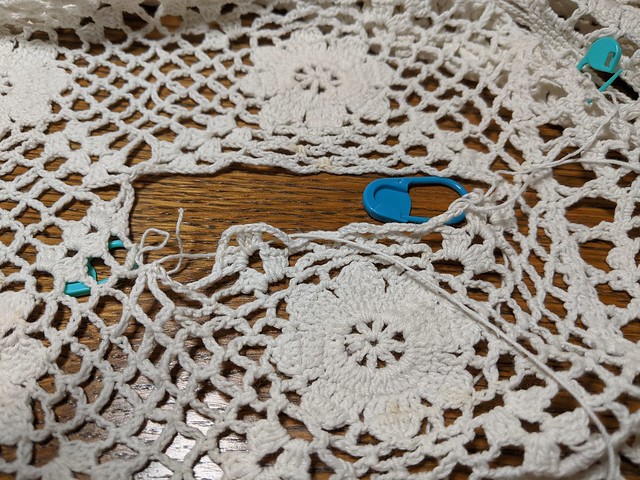
rectangular lace crochet tablecloth with center border and then outer border made up of flower motifs
One of my favorite repairs, recently, has been a series of two different crochet lace tablecloths I took on. These two pieces were both at least 30 or more years old, and were in pretty good condition. Frank from Textile Restoration Inc in Chicago had sent the client my way. I’ll highlight the first of the tablecloths today, and I’ll be highlighting the second of them a little later.
The first tablecloth, which I thought of as “Field of Flowers” when I worked on it, was a huge piece, at least 5 1/2 feet by 4 feet. It was made of a center pannel of 4 x 12 motfs, an inner border of triangles, an outer set of motifs 4 deep, and then larger second outer border.
Most of the holes were areas where motifs that had been joined as the tablecloth was worked had come undone and unraveled – not uncommon, even in pieces where every single end is tightly woven in. The areas where two motifs join together tend to be an area that recieves more stress.
You can see here one such area, where two rows of the motif have come undone and unravled – perhaps the tablecloth got caught as it was being folded up to be put away.
The first step of working a repair, counterinutively, is always making the hole bigger. Why? I want to pull back the thread or yarn until I get to thread that is whole and not worn away or damaged. the two teal markers are holding the damaged yarn out of the way in the back, the orange and blue markers are where I’ll be joining the new yarn to the old yarn. I always like to pull back in lacework like this to a cluster of stitches if I can – it’s easier to weave in and hide the old and new ends in a cluster of double crochet than alone.
Now I’ve joined the new thread and crochet across the hole, joining the new yarn to the old where the first of the two teal markers are. The final row, in crochet or knitting, is always the row that closes the hole up, and takes the longest of all the rows.
Once I’ve gotten the second row closed up and re-crochet, it’s time to weave in the ends. You can see that while the new thread I used is a good match for color and weight, it does have a sheen – that’s because it’s new, and hasn’t been washed, used and reused over and over again. Over time the “new” yarn will loose its sheen and match the rest of the piece more.
The last step is to check and make sure I’ve correctl done the pattern, and if it looks okay, weave in the ends. I mark the repaired hole with a piece of contrasting color thread – both for the client when they get it back, and for me to make sure I keep track of where I’ve worked and where work needs to be done.
While I don’t always manage to do it, I try and get a few pictures of the pieces I’ve repaired before I mail them back to the clients. It’s also a chance to take one last look at the piece and make sure I haven’t missed any areas – you’ll see in this picture one locking stitch marker noting a place that needs attention before I send the piece back home.
Loved this tutorial? Check out more crochet repairs I’ve done here.
Know someone that need a piece of theirs repaired? I’d love to talk to them! You can contact me here.







